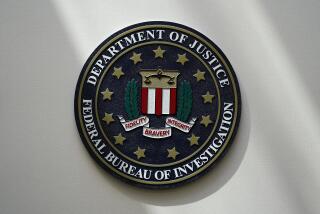U.S. agents race to exploit data from Bin Laden raid
- Share via
Reporting from Washington — U.S. intelligence agencies are racing to exploit a trove of documents and computer files that U.S. Navy SEALs collected from Osama bin Laden’s compound in Pakistan before other Al Qaeda groups or leaders can change their communication methods or move their safe houses.
Many of the files are written in multiple languages, and some appear in code, U.S. officials said.
“At first blush, there appears to be some value,” said Rep. Mike Rogers (R-Mich.), chairman of House Intelligence Committee, who was briefed on the effort Wednesday.
Photos: The death of Osama bin Laden
The CIA has created a special task force in Afghanistan to analyze Bin Laden’s material for clues to ongoing terrorist plots, the location of other Al Qaeda leaders, funding streams and other fresh intelligence.
The National Security Agency’s eavesdroppers also have stepped up efforts to pick up unusual “chatter” from Al Qaeda leaders or sympathizers around the globe following the predawn raid Monday by Navy SEALs that killed Bin Laden and four others.
U.S. counter-terrorism officials worry that Al Qaeda cells or affiliates may accelerate existing plots to make sure attacks are launched before U.S. intelligence agents can chase down new leads. Attack timelines also could be moved up in order to avenge Bin Laden’s death.
Experts say major terrorist operations, especially those involving multiple targets, usually take months or years of planning. Any attempt now to change or speed up those plans could create an opening for agents to intercept a message or gain other intelligence to help foil a plot.
U.S. intelligence agents have found that the confusion and reorganization after the capture or death of senior operational leaders for Al Qaeda, to be a fruitful phase for the collection of information.
With Bin Laden gone, analysts also are watching to see if anyone rises to challenge the putative heir apparent and longtime top deputy Ayman Zawahiri.
If Bin Laden was the inspirational leader and financier of Al Qaeda, Zawahiri was seen as the organizational mastermind. But he is far less popular and lacks the charisma and personal narrative that drew fighters to Bin Laden’s side.
“Al Qaeda is an uneasy alliance of terrorists of different backgrounds,” said a former U.S. intelligence official who has interrogated militant detainees. “Some of these guys can’t stand each other.”
One possible challenger is Abu Yahya al-Libi, a propagandist for Al Qaeda who became a militant folk hero when he escaped from the U.S.-run prison at the Bagram Air Base in Afghanistan in 2005.
But some analysts suspect that the Libyan-born cleric’s dark skin may increase the odds against his acceptance by some rank-and-file fighters from the Arab world.
“Jihadists are capable of racism too,” said Stephen Tankel, an expert on Al Qaeda at the Carnegie Endowment for International Peace, a Washington-based think tank.
Photos: The death of Osama bin Laden
More to Read
Sign up for Essential California
The most important California stories and recommendations in your inbox every morning.
You may occasionally receive promotional content from the Los Angeles Times.











